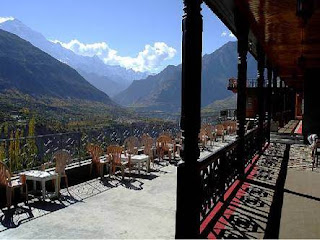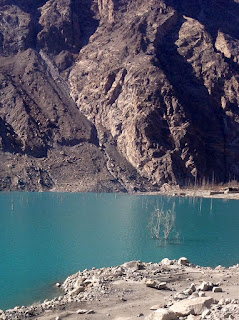THIS LAND OF OURS IS A BEAUTIFUL LAND
REMINISCENCES OF TRAVEL TO HUNZA ON KKH
"When we get closer to nature, be it untouched wilderness or a backyard tree – we do our overstressed brains a favour” - National Geographic Magazine (January 2016).
Having seen what ever we could in the three days that we
remained in Hunza, the time had come to trek back to the world of our own, a world none of us wanted so soon to come back to but for reasons a plenty we had to. We had packed the night before for an early departure in the morning of
November 8, 2016. Tracing the return path, we passed by tall and yellowing poplar trees camouflaging and obscuring the villages on the way. The shadow of huge dark mountains in the background hanging over the villages as if those were their custodians and sentinels and so they really were for eons and centuries, all that however was now pristine and serene. The sign of good life being neatly dressed children going to schools nearby. One reality, which will never be lost on us and which had come to stay with us was the realisation that sending children to schools was an integral part of their lives. It was ingrained in their society and was simple and vividly visible. We felt sorry for leaving all that behind. Everyone kept quiet with wrenching hearts. We surly had left our souls behind. Our Toyota Hiroof kept moving at a brisk pace on the downhill KKH and in almost no time took us to the Diran Guesthouse in the picturesque Minapin. After staying there for a while, we resumed our journey, this time heading towards Gilgit and on to Chilas and Dasu in the dreaded Kohistan. The previous nightmarish travel on the stretch of KKH from Dasu to Chilas being still fresh in our minds. We arrived in Besham late in the evening, where we stayed overnight at the PTDC Motel. After a good night's rest, we were again on the trail till we arrived in Abbotabad, where we had lunch at a decent hotel, resuming our return travel before reaching our farmhouse near Taxila in the evening of November 9, 2016. This episode is a narrative of our observations and experiences as we travelled back from the Dreamland Hunza.
________________________________
DAY 4 (November 8, 2016)
DEPARTURE FROM HUNZA
We were told by the owner of the guesthouse that several groups come to stay there for climbing the Diran Peak and trekking to the Rakaposhi base camp in the summer season. There was a fruit orchard with a plenty of apricot trees cladded in orangish gold leaves of autumn. The fallen leaves were strewn all over the place. We took pictures and after taking tea in the lawn left for Gilgit just after 11 in the morning.
After our visit to Baltit Fort, which was our last engagement in Hunza, we worried ourselves with buying souvenirs and gifts for friends and folks back home. The hottest thing on every one's mind was the Hunza Walnut Cake, which we had already ordered at the Cafe De Hunza on the first day of arrival in Hunza
We collected our individual cakes from Cafe De Hunza while returning from Baltit Fort. The cafe is situated on Karimabad Road quite near the Serena Hotel and not far from our Embassy Hotel further down the road. It seemed to be quite popular with tourists who also frequent it for coffee and getting access to WiFi for internet and emails. As the cakes were being boxed, we chatted with the proprietor. we found him a very friendly person. He told us he received training for making the walnut cake in Switzerland. He was also a bicycling enthusiast and informed us that he often goes to Islamabad where he bicycles from Daman-e-Koh to Taxila and Khanpur Dam. We saw several sports bicycles parked outside his cafe, which he seemingly rented to tourists desirous of visiting places within Hunza and nearby scenic villages.
 |
| Cafe De Hunza - The Walnut Cake Place (picture borrowed from public domain) |
 |
| Location of Cafe De Hunza (map borrowed from public domain) |
As we boarded our transport, we looked back at the Embassy Hotel, which was our base camp in Hunza all through.
The Balcony Right Infront of Our Rooms and a sprawling Terrace Down Under
for Magnificent View of Mountain Peaks (Picture Courtesey Embassy Hote
We had plans to leave Hunza by 7:30 in the morning and take breakfast at Minapin but for the last minute unavoidable delays, we had to stay back for breakfast at the Embassy Hotel itself. We couldn't as such be on the road any earlier than 9:00 AM. Travelling back on KKH leaving behind Aliabad and Murtazabad and having crossed the Hunza River, we took a sharp left turn a little before Ghulmet on the Pissan-Minapin road to reach the Diran Guest House in Minapin. We found it to be another serene and superb place in Hunza Nagar Valley. It took us 45 minutes to cover a distance of 34 kms from our hotel in Karimabad to Minapin.
Nested in the well populated village of Minapin, the Diran guest house was utmost peaceful. Its outdoor spacious lawn was truly awesome. As we entered the gate we could see the Diran peak right infront and the Rakaposhi slightly on the right.  |
| Little Children of Minapin |
 |
| A Hanging Bridge on River Gilgit |
Gilgit to Besham was a long drive. We remembered the road starting from Raikot Bridge was not in very good condition and it was difficult to cover a great deal of distance in good time. The KKH passing through Gilgit was still closed and we were constrained to take the detour yet again.
We passed by Gilgit just after 12:00 noon and kept on the road without stopping even for taking pictures. The Rakaposhi on our left remained in our view and we could take the pictures sitting in our Toyota van. It was still not too late but the drive to Besham was expected to be tough, as it would most certainly get dark while we would still be in the dreaded Kohistan. The driving in the dark on these mountain roads as we understood was quite precarious. There was hardly any greenery on the way except along the Gilgit River and the streams that rush down along the side valleys to meet it.
However, travelling on the country roads as always was enjoyable as it afforded us a lot of scenic views. In that context the emrald green water of Gilgit River is still fresh in our minds and crossing the river via a steel wire hanging bridge remains one of the reminiscents of that travel.
 |
| A View of Rakaposhi from KKH |
We reached Chilas in good time but after skipping lunch headed for Dasu in real haste. As we travelled an altogether unexpected struck like a bolt of lightening as our ever reliable Toyota Van started screeching giving troubling noise with a rear wheel jam as we passed the site of Diamer Bhasa Dam. That forced us to break our journey at Dasu where we got an amateurish and inexperienced mechanic to tinker with it under the unfriendly gaze of the Kohistani onlookers. Luckily at the end of the fiddling process he succeeded in making the jammed wheel satisfactorily movable. We were aware of the story of girls who had recently been mercilessly killed by the Jirga for having participated in singing and dancing in an exclusive wedding ceremony of women and on that count were extremely nervous and petrified. That was the most unpleasant part of our journey when even the looks of constabulary appeared to us somewhat hostile.
 |
| The desolate and barren hills of Kohistan |
Even though it was terrifying but still incredible that the repairs could be made at that remote and hostile place and we were happily on the move again. It quickly got dark subsequently and the only lights on the road were those from our Toyota Van. The drive was tense, spooky and scary. The mountains appeared like black shadows. We passed Pattan by eight at night and reached the Besham PTDC Motel by 9:30 P. M. The PTDC staff was quite considerate and were helpful in several ways. It was past eleven when we retired for bed. As per program we got ready early and after a somewhat heavy breakfast at the motel resumed our travel but not before availing the opportunity to assemble for a group photo, which was the last such snap taken. Although our travel together did not provide much in the way of fraternisation, yet it did generate a lot of good feelings and consideration for each other.
The US election results were being received on mobile phones and to our great astonishment as well as disappointment those were all against the popular expectations. We kept discussing the changes appearing on the world political scene - first the Brexit and now reversing of the forecasts in the US presidential election. We kept discussing how it would be like with Donald Trump in the White House before we arrived in Abbotabad, where we stopped for lunch. The rest of the travel was non enterprising. The life was same as we left it, with dirt and smog all over, the down trodden masses and incomprehensible rush of the people moving about in search of their livelihood. The traffic with bottlenecks at places around cities slowed us down from time to time but we reached our farmhouse, well in time just after 3 P. M while rest of the party continued on to Lahore.
As I wrap up this last edition of the blog relating to Hunza Safari, I must profusely thank the trip organiser Mr Mubashar Azam who was relentless in trying to ensure the safari was free from any hiccups. He made best of the arrangements under the circumstances and kept every body happy. His company too was joyous and enjoyable. Here, I would like every one to join me in three cheers for Mr Mubashar hoping to join him again in the future WWF programs of similar nature.




























